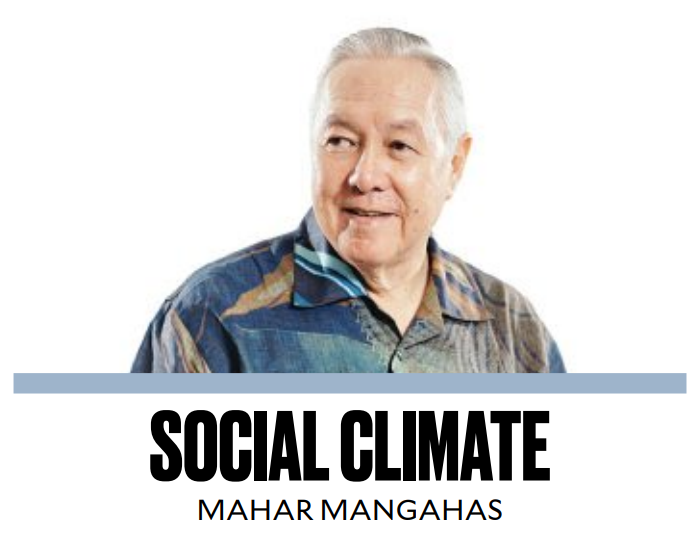Poverty: the latest reminder

The main economic problem in the Philippines is its massive poverty, as sensed by the people themselves. In December 2023, almost half of all families felt Poor, only one in five felt Not Poor, and one in three felt on the border—a very wide border—between the two (see “Social Weather Report: 47% of Filipino families feel Poor, similar to 48% in September 2023; 33% feel Borderline, and 20% feel Not Poor,” www.sws.org.ph, 1/17/24).
To estimate the absolute numbers of the poor, one should apply the survey percentages to the total number of Filipino families, as projected by the Philippine Statistics Authority (PSA). For 2023, Social Weather Stations (SWS) uses the PSA projection of about 27 million families, thus estimating 13 million as Poor, 9 million as Borderline, and 5 million as Not Poor. (Incidentally, the Borderline should not be called “Borderline Poor” since they are as much “Borderline Not Poor” as well.)Poverty is higher in the South. The latest percentage of the Self-Rated Poor (SRP) was 37 in the National Capital Region (NCR), 39 in Balance Luzon, 58 in Visayas, and 61 in Mindanao.
These were nearly the same as last September, except that in Mindanao it had fallen from 71. The 10-point fall in Mindanao made up for a 17-point rise from June to September.Poverty has been very sluggish over time. The SRP percentage was high all year long: 51 in March, 45 in June, and 48 in September, or an average of 48 percent for the four quarters of the year. The first half and second half of 2023 have the same average of 48 percent.
The annual average was also high in previous years: 48 in 2022, 46 in 2021, 48 in Quarter IV of 2020—it was impossible to do face-to-face surveys in Quarters I-III—45 in 2019, 48 in 2018, 46 in 2017, and 44 in 2016. This shows that the poverty incidence has not quite recovered to its best achievement prior to the pandemic.
There have been 142 national surveys of SRP since 1983. The series has been quarterly in 1992, so as to compete for attention with the quarterly gross national product statistics. It is, to my knowledge, the world’s most rapid survey-based monitoring of poverty. The lowest SRP annual rate was in 2016: it had been in the ’50s, ’60s, and ’70s before then. There are plentiful data behind the statement that Philippine poverty is massive now, even though it had been larger in the past.
Poverty thresholds and poverty gaps. Backing up the realism of the surveys is the question to the Poor of how much the family needs for monthly home expenses—which excludes transportation to work and other costs of earning—in order not to feel that way. This gives the Self-Rated Poverty Threshold (SRPT). The national median SRPT in December 2023 was P15,000 per month. It is what half of the Poor, or the poorer 24 percent, said they needed; I think it’s very modest and realistic.
Furthermore, SWS also found the national median Self-Rated Poverty Gap to be P7,000 per month. It is what half of the Poor said they lack, relative to their Threshold. It’s almost half of the need and therefore is very substantial.
Food Poverty. Using similar methodology, and referring to the quality (not the quantity) of food taken by the family, the December 2023 survey found the Food-Poor at 32 percent, the Food-Borderline at 41 percent, and the Not-Food-Poor at 26 percent. In absolute numbers, using the PSA base, that means 9 million Food-Poor, 11 million Food Borderline, and 7 million Food-Not-Poor. The December 2023 Food-Poverty percentages were 24 in NCR, 27 in Balance Luzon, 38 in Visayas, and 43 in Mindanao.
SWS has done 102 national surveys of Food-Poverty since 1988. The annual average percentage food-poor was 35 for 2023, 33 for 2022, 31 for 2021, 31 for 2020 (Quarter IV only), and 31 for 2019. This shows failure as yet, to recover to the pre-pandemic situation.
The current national median Self-Rated Food Poverty Threshold is P8,000 per month, which is again a modest and realistic amount. The national median Food Poverty Gap is P3,000 per month, which is again substantial.
Solving poverty calls for steady reminding about it. The PSA recently upgraded its poverty monitoring, using a minimum-income poverty line, from triennial to biennial. Its base data is the Family Income and Expenditure Survey (FIES), which had been done every three years in 1985 to 2021, and will now be done every odd-numbered year starting with 2023. The FIES fieldwork for income in January-June 2023 was done last July or so. Its fieldwork for income in July-December 2023 may have started already. If PSA publishes each half separately, then their trend may be compared with the SWS quarterly trend in 2023.
However, then the PSA poverty statistics will have gaps in 2024, 2026, 2028, and so on. In my opinion, the Filipino people, and their development-oriented institutions, deserve to be informed of the progress (or regress) in poverty yearly, or better yet quarterly as SWS has been doing.
Contact: mahar.mangahas@sws.org.ph.
Dr Mahar Mangahas is a multi-awarded scholar for his pioneering work in public opinion research in the Philippines and in South East Asia. He founded the now familiar entity, “Social Weather Stations” (SWS) which has been doing public opinion research since 1985 and which has become increasingly influential, nay indispensable, in the conduct of Philippine political life and policy. SWS has been serving the country and policymakers as an independent and timely source of pertinent and credible data on Philippine economic, social and political landscape.




















